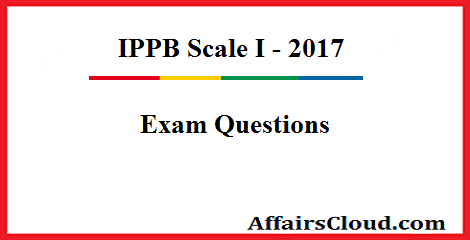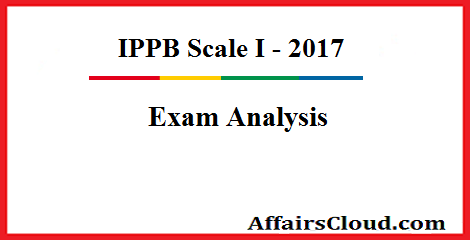IPPB conducting Prelims exam for the post of PO across India on January 7-8, 2017. 4 Shifts per day scheduled in various exam centre.
We are collected some of the Questions asked in Todays exam(07.01.2017)
Questions Asked in English Section:
Cloze Test– Based on air pollution in China
THE capital’s “airpocalypse”, the choking smog that descended on Beijing in the winter of 2012-13, galvanised public opinion and SPOOKED the government. The strange thing is, though, that information about air pollution—how extensive it is, how much damage it does—has long been sketchy, BASED mostly on satellite data or computer models. Until now.
RESPONDING to the outcry, the government set up a national air-reporting system which now has almost 1,000 monitoring stations, pumping out hourly reports on six pollutants, including sulphur dioxide, ozone and (the main CULPRIT) particulate matter less than 2.5 microns in diameter, or PM2.5. These are tiny particles which lodge in the lungs and CAUSE respiratory disease. The six are the main cause of local pollution but have little to do with climate change, since they do not include carbon dioxide, the main greenhouse gas. Scientists from Berkeley Earth, a not-for-profit foundation in America, have TRAWLED through this recent cloud of data for the four months to early August 2014, sieved out the bits that are manifestly wrong (readings where the dial seems to be stuck, for instance) and emerged with the most detailed and up-to-date picture of Chinese air pollution so far.
Pollution is sky-high EVERYWHERE in China. Some 83% of Chinese are EXPOSED to air that, in America, would be deemed by the Environmental Protection Agency either to be unhealthy or unhealthy for sensitive groups. Almost half the population of China experiences levels of PM2.5 that are ABOVE America’s highest threshold. That is even WORSE than the satellite data had suggested.
- Reading Comprehension based on African Urbanization
- Error Spotting based on tenses & subject verb agreement and Singular, plural based
Questions Asked in Quants Section:
- 180 191 193 203 206 215 ?
- 418 208 102 48 ? 5
- 153 155 160 170 187 ?
- 3, 1.5 ,1.5 ,3 ,12 ,?
- 3, 4, 9, 28, ?
- 15, 20, 38, 45, 696
- 256, 176, 216, ?, 206
- 100, 51, 53, 109, ?
- 2, 4, 10, 32, ?
Solution:
Q1.+11….+2….+10….+3….+9….+4
Q2.x0.5-1….x0.5-2…x0.5-3….x0.5-4….x0.5-5
Q3.+2…..+5….+10……+17…….+26
………+3…….+5…….+7……+9
Q4 .x0.5….x1…..x2…..x4……x8
Q5 .x1+1….x2+2….x3+3….x4+4
- Two taps can fill a tank in 12 hrs and 18 hrs and a third tap empty the tank in 72 hrs when all three are opened together then tank will be filled in how many hrs ?
- X is 32 years old. If X’s age is 16% greater than that of Y then by how much percent is Y’s age less than X’s age?
- A and B can together finish a work in 36 days. They worked together for 4 days and then A left for another job. After another 8 days, B finished the remaining work. In how many days can B alone can finish the work?
- Two trains of similar lengths take 20 seconds and 45 seconds respectively to cross a phone post. If the length of each train is 165 metres, then in how much time will they cross each other while travelling in opposite direction?
Others:
- Approximation – easy and solvable
- Quadtratic Equation – easy and calculative
Questions Asked in Reasoning Section:
Circular Arrangement
A, B, C, D, E, F, G and H are sitting around a circular table at equal distances between each other, but not necessarily in the same order.
B faces outside. D sits second to the left of B. A and F are immediate neighbours of D. H sits second to the right of A. C sits third to the left of H. E sits to the immediate right of G. D sits third to the left of E. D faces the same direction as H. F sits to the immediate right of C. F and G take same directions.
Seating Arrangement
Ten people are sitting in two parallel rows. In row-1 A, B, C, D and E are seated (but not necessarily in the same order) and all of them are facing north. In row-2 J, K, L, M and N are seated (but not necessarily in the same order) and all of them are facing south.
B sits third to left of A. The one who faces B sits second to right of J. Only one person sits between J and M. One of the immediate neighbours of J faces C. K and L are immediate neighbours of each other. L does not sit at any of the extreme ends of the line. One of the immediate neighbours of A faces M. M does not face E.
Floor Puzzle:
Eight people D,E,F,O,P,Q,R,S lives on 8 different floors .The lowermost is numbered 1 and the top most is numbered 8.
Q lives on an odd numbered floor but not on floor 1.P lives immediately above Q but not on the topmost floor.There are 3 people’s between P and R .The no of people below P is equal to the no. Of people above D. Two persons live between E and P and E lives immediately below R..F lives immediately above O
Others:
- Coding & Decoding old pattern asked in today’s exam
- How many such pairs of letter in the word, each of which has between them in the word as in English alphabet ?
For Tomorrow Exam :
Now we can get the clear idea about exam pattern, so we should plan to crack the exam.First attend the easy questions in all section then go to DI, Puzzle to score more marks.
Note: If you remember any questions, try to share it in command section, we will update it.




